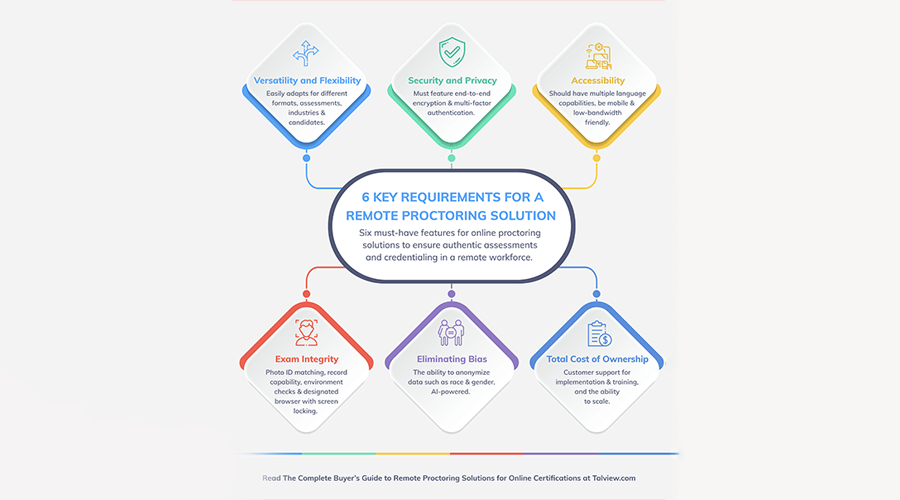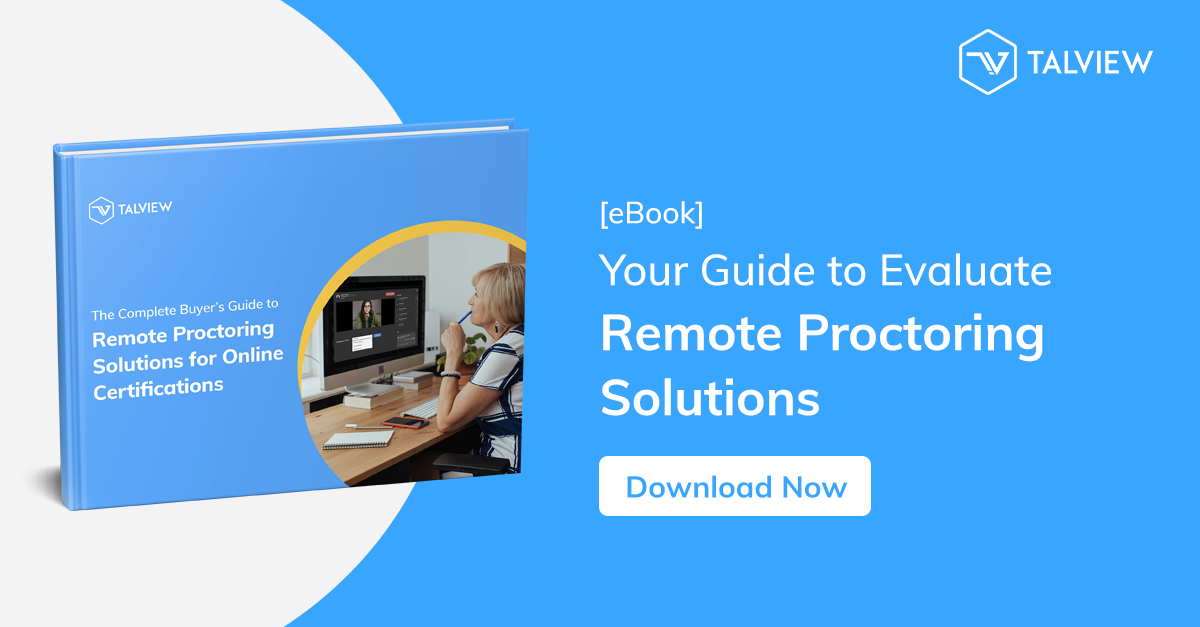Accessibility and Exam Integrity: Essential Elements of Online Proctoring
This is Part 2 of our three-part series. Read Part 1 here.
Once you’ve narrowed down your list of remote proctoring solutions that cover the basics of flexibility and security, it’s time to sharpen your focus even more to find the perfect solution for your company. The following pieces of the puzzle involve examining the solutions’ capabilities for accessibility and exam integrity.
We’ve identified a total of six critical considerations when shopping for a remote/online proctoring solution and created a Complete Buyer’s Guide to Remote Proctoring to help you get a better idea of what to look for. This series aims to highlight the key points from our eBook and dig into the essential elements of the ideal solution:
- Part I: Versatility & Flexibility and Security & Privacy
- Part II: Accessibility and Exam Integrity
- Part III: Eliminating Bias and Total Cost of Ownership
Accessibility
One of the undeniable benefits of adopting remote proctoring solutions is increasing the overall accessibility of exams for candidates. Since test-takers don’t have to travel to a testing center, they can choose a testing environment that makes them feel more at ease.
For example, one candidate may want to reserve a private room at their local library to minimize disruptions. Another may feel more comfortable taking their test at their desk at home. With high-stakes tests, remote proctoring allows candidates to take their exams wherever they’d like, and when they feel more secure, they’ll perform better.
But the location of the test shouldn’t be the only accessibility consideration. Remote proctoring solutions have the opportunity to be constructed to meet the diverse needs of candidates.
Additionally, not all your test-takers may speak English as their first language. Exams can be complicated enough without needing to translate every question before determining a response. Offering your exams in multiple languages levels the playing field for candidates who are more comfortable taking a test in their native tongue.
Another aspect of accessibility includes ensuring that candidates can complete the exam on whatever device or connection speed they have available. Your remote proctoring solution should enable people to focus on the test content, even if they don’t have a PC and strong internet connection.
Your online proctoring system should work as well on mobile devices and low-bandwidth connections as it does for test-takers using a dedicated connection. People shouldn’t be excluded or penalized because of their resources, and your proctoring solution should make test-taking a breeze for anyone, anywhere.
Buyer’s Checklist for Accessibility in a Remote Proctoring Solution
When looking for a remote proctoring solution that offers the greatest level of accessibility to your candidates, shop for software that:
Exam Integrity
Alongside security, maintaining exam integrity is a primary concern for administrators. Preventing cheating is a top priority for any certification exam, especially since dishonesty in online exams is more likely to occur in a non-proctored environment.
The good news is that exam integrity isn’t automatically compromised by offering online tests. The right remote proctoring solution will allow you to prevent cheating with multiple authentication features.
Your remote proctoring solution should provide end-to-end checks to avoid cheating from log-in to submission. The system should incorporate multiple authentication checks to prevent others from impersonating the test-taker when the candidate signs onto the portal to begin the exam.
When the candidate launches the exam, the solution should take them to a dedicated exam browser that locks down their screens to prevent the test-taker from accessing other files, pages, and documents. Top-tier solutions will also offer environment checks, question paper watermarking, and browser patrolling.
The best remote proctoring solutions enable photo ID matching and advanced video and audio analytics to flag any potential malpractice as well as monitor communication between the invigilator and the candidate.
If your organization needs to offer automated proctoring, look for a solution that allows record-and-review testing capabilities so you can check for malpractice.
The top solutions utilize artificial intelligence (AI) and machine learning (ML) technologies to identify any abnormalities or potential cheating without requiring administrators to have a human being monitor each individual exam. If the solution flags a possible problem, the administrators can review the recording of the test-taker to check for malpractice.
Buyer’s Checklist for Exam Integrity in a Remote Proctoring Solution
When shopping for an online proctoring solution that offers end-to-end exam integrity, look for a system that:
Includes Browser PatrollingOffers Designated Exam Browsers with Screen Locking
Provides 360-degree Environment Checks
Enables Question Paper Watermarking
Is Equipped with Photo ID Matching
Facilitates Real-time Communication Between the Proctor and Candidate

The Wrap Up on Accessibility and Exam Integrity
We hope this gives you more focus in your search for an online proctoring solution. Before we move to our final part of the series, let’s recap the key takeaways from Part II:
- The best solution enables test-takers to complete their exams wherever they’re most comfortable
- The right solution will provide multiple tools to ensure that candidates have the best chance of success when taking the exam
- Your remote proctoring solution should maintain exam integrity from log-in to submission
- The top solutions will harness powerful analytical tools that allow you to offer automated proctoring
Brief Preview of Part 3 – Eliminating Bias and Total Cost of Ownership
Part 3 of this series will focus on the last two critical features of a remote proctoring solution: eliminating bias and total cost of ownership.
Eliminating Bias
For eliminating bias, we’ll discuss the need for features such as:
- AI and ML assistance
- Anonymized data on demographics
Online solutions inherently reduce test-taking bias, and your online solution should enhance your ability to eliminate bias altogether.
Total Cost of Ownership
Last but not least, we’ll address how you can determine the total cost of ownership for your online proctoring solution. The overall ownership costs include:
- Provisions for training proctors
- Scalability for customer needs
- Potential for updates and enhanced features
- Price of system implementation and user training support
- Professional services capabilities
The Complete Buyer’s Guide to Remote Proctoring eBook
We’ve created a Complete Buyer’s Guide to Remote Proctoring to help you understand what to look for as you research the various platforms available.








Leave a Reply